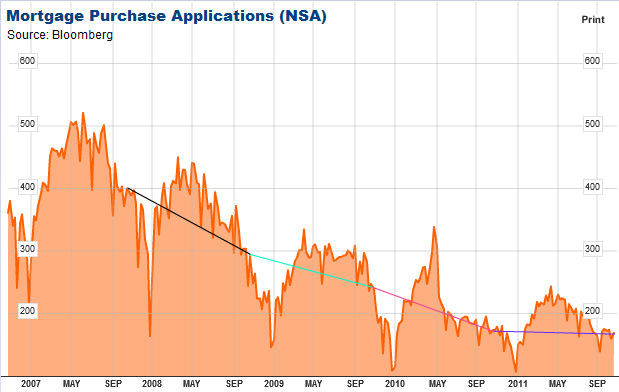Courtesy of Lee Adler of the Wall Street Examiner
Purchase mortgage applications rose 6.4% last week according to the Mortgage Bankers Association and major media outlets. As always, the media report only the seasonally adjusted data fed to them by the MBAA. Rarely should a week to week change have any seasonal effects, although last week would be an exception because the week before included Columbus day, when only a few hardcore addicts would be out taking apps. So the suppliers of the data make up a number to account for that, and off they go. By the same token, the not seasonally manipulated week to week figure is probably of equally little use.
Week to week changes are rarely meaningful to begin with. We’re always more interested in the trend, and whether that trend is showing signs of change. For that purpose, the year to year change is far more important. Bloomberg provides a chart of that data, not seasonally massaged, going back 5 years, which includes the beginning of the housing meltdown. The year to year change in the latest reporting week (October 21) was a decline of 2.6%. That’s not good, considering that the market was already at rock bottom levels. But the picture of the last 5 years tells a different, and somewhat more hopeful story. The rate of decline has slowed to a crawl. The market is no longer collapsing.
Additional considerations are the fact that real estate brokers continue to report that large percentages of contracts are falling through. In the latest NAR report for September brokers reported a fallout rate of 18% versus 9% in September 2010. Combined with the current mortgage applications data, that suggests an overall decline in effective purchase demand of 12%. OK, so that really is terrible. But it is at least a hopeful sign that buyers are willing, if not not able, sometimes through no fault of their own. Some of this is due to credit rating (effective demand), and some is due to low appraisals, which is an external constraint on demand.
The willingness to buy is a first step, but prices must stabilize so that appraisers can stop applying downward adjustments that result in a value opinion below the contract price. Appraisers also have a problem with listing comparables in some markets, when REOs are listed at prices less than the contract price between buyer and seller. A house cannot be worth more than a house down the street listed for a lower price, regardless of who owns the listing, man or beastly bank.
In that respect, distressed supply constrains effective demand. This problem is concentrated in the hardest hit, post bubble areas like Florida, California, Nevada, and Arizona, where lender REOs are listed in the MLS listings in large numbers. It is less of a problem in most other areas of the country, and we are seeing prices stabilizing in many metro areas. Less distressed markets can recover sooner than distressed markets even though distressed markets have had much larger price declines and are cheap relative to median market household income in many cases.
The other consideration is the level of cash purchases. These will put a floor on the market where they constitute a significant percentage of sales because appraisals are not necessary. Where there’s no appraisal contingency in the contract, a real, effective meeting of the minds has been established. Brokers reported cash sales were 30% of the market in September, little changed from 29% last September. As a result, price declines, while continuing in many areas, have leveled off over the past year.
The slowing of the rate of decline in mortgage purchase applications is a hopeful sign, but the market cannot stabilize until purchase applications increase and the rate of denials stops increasing.
As lenders hold more shadow inventory off the market, it becomes less of a supply threat over time, because the physical, and in many cases locational, deterioration of those properties renders them noncompetitive with non distressed inventory. An appraiser would not need to consider a listing that has been stripped of all its copper wiring, or where needed repairs are so great that the typical buyer would not consider the property competitive. In many cases the obsolescence becomes so great that these properties, and indeed whole communities, may become unmarketable altogether. It’s inventory that ceases to be inventory for all practical purposes, but I know of no one who has attempted to deduct those numbers from shadow inventory. For this reason the shadow inventory threat is grossly overrated in most areas that still retain long term viability.



